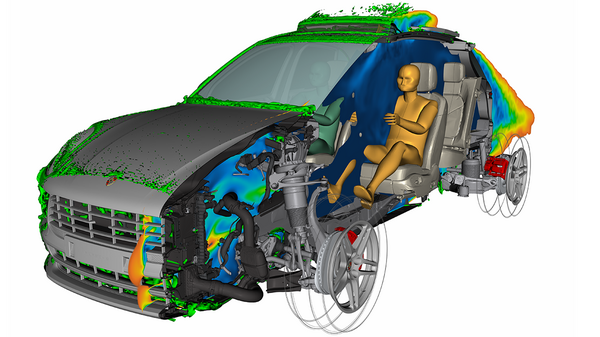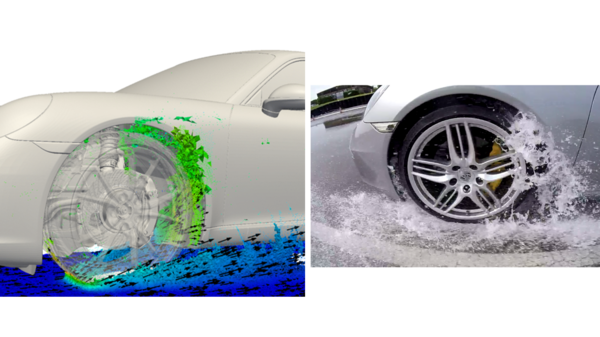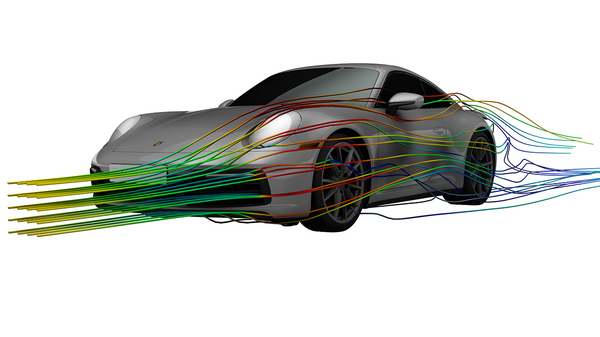High-Performance Computing Center Stuttgart

These experiences have given Wierse a unique perspective on HLRS's evolution, particularly with respect to its support of industrial applications of high-performance computing (HPC). In this interview she explains how Porsche uses HPC and artificial intelligence (AI) for automobile development, and reflects on the opportunities that access to HLRS's computing resources makes possible.
At Porsche, simulation has become more and more the foundation for vehicle development. For example, new functions (e. g. assisted driving, connectivity) are being added in cars and it's important that all of the possible constellations are tested. This challenge becomes even more complicated when you consider that we don't only build cars for Europe, but also for other countries where humidity, temperature, and street conditions can vary widely. The amount of testing that is necessary is really crazy and because of that we use state-of-the-art simulation methods.. Using simulation enables us to deliver a comprehensive “verified“ vehicle; that means a vehicle that has been fully tested virtually. Furthermore, simulation makes it possible to make decisions early (e. g. release of components), saving development time and costs, and can replace the need for hardware in form of vehicles, test benches, and real components.

Years ago Porsche had fewer product lines than it does today. Nowadays we don't only have the 911, but also the Cayenne, Panamera, Taycan, and others. In the past this meant that we would have peaks where we needed a great deal of computing power, and then there would be more relaxed periods when less computation took place. Today we are in the situation where we need a lot of computing time on a continual basis.
Although Porsche has its own computers, we have nothing even close to the size of what HLRS makes available. When doing aerodynamics simulations, we use several thousand cores on Hawk. For virtual crash tests in which we need to model joining technologies, however, scaling to such a large number of cores can be very difficult. Therefore, what is often more important to us than scalability is the throughput; that is, computing resources at HLRS give us the possibility to run a large number of smaller simulations in parallel.
From this perspective it has always been to our advantage that HLRS's resources can breathe, so to speak. On the one hand, HLRS has a large-scale supercomputer, on the other it also operates systems with a variety of architectures, including systems with GPUs (graphic processing units) for artificial intelligence.
There is a lot of talk today about the idea of cloud computing, where you just access resources when you need them. Although no one ever described it in these terms, this is something that we have done for a long time with HLRS. We have a direct and secure connection, and, the data transfer is for the most part automated. We have solved all of the key problems and because of this I would say that our HPC cloud lives at HLRS.
Although there are a lot of things that we can simulate, there are always gaps. The effects of weather conditions or dirt, for example, can be very important to how successful a car is but are also difficult to model. This is why I think it is a good thing that so many academic research projects are running at HLRS, as we will eventually be able to use the results once they are incorporated into commercial codes.

We have also always worked with HLRS in the context of industry-supported doctoral research projects in which we focus on topics in simulation with relevance to high-performance computing and automobile development. Six years ago, for example, we wanted to understand water management better. Where does water go when you drive through a deep puddle? Or if it rains, will it leak into the trunk when you lift the rear hatch? A colleague here at Porsche did research on this topic with support from Prof. Michael Resch, using the computing resources at HLRS. Since then we have implemented the results in ways that enable us to identify problems early in the product development. The cooperation enabled us to take some significant steps forward.
Artificial intelligence has become a huge theme in method development at Porsche. At HLRS we compute tens of thousands of crash simulations of a complete automobile. This is incredible, but it also creates a big problem: the effort needed to look at thousands of small components in order to determine whether some panel was bent is getting larger and larger. We'd like to use AI to make this easier.
And there are other applications. Using AI, for example, we have been developing what we call metamodels that let us make calculations faster. We are also using AI on test benches to identify inconsistency early in tests. In addition, we can also use AI to avoid situations in which we need to take a car apart simply to mount another sensor at a certain position in the car.
Such applications are not just a question of data analysis methods — we also need a lot of IT support. HLRS can also help us to meet these new challenges.
Together, HLRS and Porsche have gone through what seems like a huge technology shift. Before I started at Cray, the focus in high-performance computers was without a doubt on vector architectures. When the Cray T3E came along, we suddenly had a significantly larger number of microprocessors and it became important to have a network that was capable of high performance with respect to latency and bandwidth. This also meant that simulation codes needed to be rewritten for the new system. Even today, things like scalability and performance optimization continue to be important with Hawk.

Availability of commercial codes has also always been an issue. Because the supercomputer is not always optimized for the relevant simulation codes that Porsche uses, HLRS has also steadily built up a standard cluster that we can access. This means that in addition to the large-scale computer there is also a sufficient number of normal clusters available. This was another way in which HLRS was able to react to help us address our needs.
Since my time with Cray, HLRS has seen a substantial growth in its computing resources. The connectivitiy, firewalls, and network bandwidth all had to grow alongside these developments at the same time. Even the smaller clusters have been expanded in parallel with the flagship supercomputer. I am very pleased about the excellent cooperation that Porsche and HLRS have built over the last 25 years and every day remain excited to see what new kinds of simulation opportunities HPC and AI can offer.
— Interview by Christopher Williams